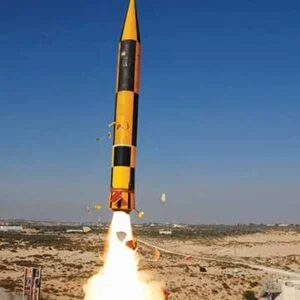Israel is continuing the upgrade of its multi layered ballistic missiles and rockets protection system. Some of the efforts are made clear to the public while others are classified. The main ballistic missiles threat is posed by Iran that has developed a long line of long-range ballistic missiles. The other threat is posed by Hezbollah terror organization in Lebanon that is fully controlled by Iran. At 2.40 AM on March 17, 2017, the officer in front of the radar display of an Israeli air force (IAF) Arrow-2 anti-ballistic missile battery saw suspicious blips on the screen in front of him.
There was no time for further consideration and a second later, an Arrow -2 missile was launched from its canister. A few second later loud explosions were heard in Eastern Israel near the border with Jordan.
Minutes before the sequence of events began, Israel Air Force (IAF) fighter jets attacked a convoy that carried advanced weapons made in Iran, and was in Syrian territory on its way to the Hezbollah terror organization in Lebanon.
When the fighter aircraft were on their way back to base, a Syrian unit launched a Russian made SA-5 surface to air missile that missed the Israeli aircraft.
But the big heavy missile continued its trajectory with a projected hit point inside Israeli territory. The Arrow-2 operator had a few seconds. The Israeli interceptor hit the Syrian missile armed with a 200 kg warhead. It exploded over Jordan.
This was the first operational intercept by an Arrow- 2 anti-ballistic missile.
But new threats are emerging in the region and that brought Israel and the US to recently launch a program aimed at developing the Arrow-4 ballistic missile interceptor. The design is aimed at dealing with new threats posed mainly by the Iranian long range ballistic missiles.
The Arrow-4 will have winglets because it is designed to intercept inside the atmosphere. There was no official explanation of that capability.

According to the Israeli MOD, the Arrow-4 will be an advanced, innovative interceptor missile with enhanced capabilities. It will address a wide range of evolving threats in the region and will replace the Arrow-2 interceptors over the next decades.
Head of the Israel missile defense organization (IMDO) Moshe Patel said on February 18 that Arrow-4 will have unprecedented flight and interception capabilities, ensuring the security of the State of Israel.
Jacob Galifat, General Manager of Israel aerospace industries (IAI), MLM division said that the new version will be the most advanced-of-its-kind in the world and will provide a new layer of defense to the State of Israel and its citizens.
The Arrow Weapon System is a major element of Israel’s multilayered missile defense array. It includes advanced radar systems, developed and produced by IAI subsidiary Elta. It also includes a BMC system developed by Elbit Systems, and a Launch Array including interceptors produced by MLM, another subsidiary of IAI. Defense industries Rafael and Tomer are also involved in the development and production of the Arrow interceptor. Arrow-2 is operational since the year 2000, providing endo-exoatmospheric defense. Arrow-3, an exoatmospheric missile defense system, was delivered for operational use in 2017. It serves as the upper layer of Israel’s multi-tier missile defense array. Over the past few years, both of the interceptors were upgraded, and demonstrated excellent capabilities during successful tests held in Israel and Alaska.

Iran has developed a variety of long-range ballistic missiles. Some are based on liquid fuel while others are powered by solid fuel.
One example is the Khorramshahr that has a reported range of 2000 km. The missiles is 13 meters long has a diameter of 1.5-2.0 m. Launch weight is approximately 19,000-26,000 kg.
According to Iranian officials, the missile is capable of carrying multiple warheads of up to 1,800 kg. The Arrow batteries are interconnected to one command center which can decide what battery or rather what launcher will achieve the best results after an incoming missile is detected by the “Green Pine” phased array radar and its advanced versions like the “Super Green Pine” (SGP). Detection is also performed by the Americans who have one missile detection X band radar system in southern Israel and share with Israel data collected by their spy satellites.
The decision on what battery will launch can be made also using the communications network between the batteries with no need to go through the central command center.
Israel has a four layered rocket and missile protection system that is operational and being upgraded continuously.
The Arrow-2 and Arrow-3 are the upper layers of a system that is designed to defend Israel from rockets and missile. The Rafael “Iron Dome” has intercepted hundreds of short and medium range rockets during the “Protective Edge” operation in Gaza in 2014.
One layer above is the Rafael-Raytheon “David Sling” designed to intercept longer range rockets and cruise missiles. All these systems are fully operational.
The threat on Israel is diversified and constantly changing. Israel has in recent years performed attacks on convoys that tried to transfer missiles from Iran to Syria.

Currently the Iranians are trying to build a production line for their missiles in Syria. Israel has declared that it will make any needed effort so that this facility will be destroyed once there is evidence that production started.
Syria is equipped with old Scud B/C/D ballistic missiles and the Iranian effort is to upgrade them and manufacture newer versions in Syria to protect them from night attacks by Israel.
But the major ballistic threat is from Iran. This country has a big arsenal of long-range missiles. While some reports in the Iranian press about new versions of existing missiles are considered false, the experts say that this country can launch a massive ballistic missile attack on Israel.
The Shihab-3 was the first intermediate range ballistic missile that was built by Iran’s military, a local clone of the No Dong from North Korea. Its first version has a range of 1,300 km. Soon after, Iran came with two new models, which has a range of 1,650 and 1,950 km respectively.
Another long-range ballistic missile is Sajil. The Iranians claim that it has a 2000 km range.
While the “Arrow-2” has a proximity fuse that detonates the warhead, the “Arrow-3” is designed as a “hit to kill” interceptor. A kill vehicle is ejected from the main missile and maneuvers itself until it achieves a kinetic kill with the incoming enemy missile. Sources said that the Arrow 4 will also be a hit to kill missile.
The “Arrow-3” will intercept outside the atmosphere. it is much smaller and lighter than the “Arrow-2” and has super maneuverability.
The US has a permanent presence in the Israeli ballistic missiles defense system. In a remote site in the Israeli Negev, the desert part of southern Israel, an American X- band detection radar has been operational for some years.
This radar detects missiles launched in “long ranges” in the Middle East and beyond.
An expert who talked with Raksha Anirveda on condition of anonymity said, “Israel needs to plan its missiles defense capabilities for many years to come. At this point there is no hypersonic missile threat on Israel but when you design such an advanced interceptor like the Arrow-4, this capability should be included as some countries develop such missiles and in the Middle East you must expect the unexpected.”
-The writer is an International Roving Correspondent of this publication
-The writer is an Israel-based freelance journalist. The views expressed are of the writer and do not necessarily reflect the views of Raksha Anirveda










